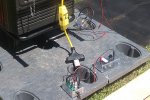For those of you who use smaller generators (e.g. the Honda EU6500-series) this is a relevant bit of electrical code information. It comes from my tracking for multiple months now on generators for entertainment use as a result of authorship of a series of article on portable generators for FOH magazine:
The NFPA posted the "short" decision on their emergency petition hearing in regards to the new NEC section, NEC 445.20. The petition was to revise the current wording of 445.20 from:
to
Page with the link to the PDF of the decision is below:
2013 Standards Council meetings
The PDF of the decision is attached: View attachment SD_13_8_17_d_D13_14_TIA1097_NFPA70.pdf
I've also attached the TIA 1097 amendment requesting the grandfathering: View attachment 70_NEC-P13_TIALog1097_ballot.pdf
The important paragraph I've quoted below (italics emphasis mine):
For jurisdictions that are going to rapidly adopt the new 2014 NEC code cycle, this obviously has substantial implications for many of the small generators currently in the field and used in pro audio, as they (NFPA) explicitly rejected the requests for grandfathering, and the upper wording of NEC 445.20, without grandfathering of any kind, will proceed into effect for 2014 NEC.
I'll let everyone know when I see the full decision if it has more details.
The NFPA posted the "short" decision on their emergency petition hearing in regards to the new NEC section, NEC 445.20. The petition was to revise the current wording of 445.20 from:
445.20 Ground-Fault Circuit Interrupter Protection for Receptacles on 15 kW or Smaller, Portable Generators. All 125-volt, single-phase, 15-and 20 ampere receptacle outlets, that are a part of a 15 kW or smaller, portable generator, either shall have ground fault circuit interrupter protection for personnel integral to the generator or receptacle, or shall not be available for use when the 125/250 volt locking-type receptacle is in use. If the generator does not have a 125/250 volt locking-type receptacle, this requirement shall not apply.
to
445.20 Ground-Fault Circuit Interrupter Protection for Receptacles on 15 kW or Smaller, Portable Generators. All 125-volt, single-phase, 15-and 20 ampere receptacle outlets, that are a part of a 15 kW or smaller, portable generator, either shall have ground fault circuit interrupter protection for personnel integral to the generator or receptacle, or shall not be available for use when the 125/250 volt locking-type receptacle is in use. If the generator does not have a 125/250 volt locking-type receptacle or was manufactured or remanufactured prior to January 1, 2015, this requirement shall not apply.
Page with the link to the PDF of the decision is below:
2013 Standards Council meetings
The PDF of the decision is attached: View attachment SD_13_8_17_d_D13_14_TIA1097_NFPA70.pdf
I've also attached the TIA 1097 amendment requesting the grandfathering: View attachment 70_NEC-P13_TIALog1097_ballot.pdf
The important paragraph I've quoted below (italics emphasis mine):
The Council has voted to deny the appeal and to not issue TIA No. 1097 or the proposed alternative. The effect of this action is that there will be no exception from complying with the requirement for GFCI protection for those applicable portable generators manufactured or remanufactured before January 1, 2015.
For jurisdictions that are going to rapidly adopt the new 2014 NEC code cycle, this obviously has substantial implications for many of the small generators currently in the field and used in pro audio, as they (NFPA) explicitly rejected the requests for grandfathering, and the upper wording of NEC 445.20, without grandfathering of any kind, will proceed into effect for 2014 NEC.
I'll let everyone know when I see the full decision if it has more details.
Last edited:






